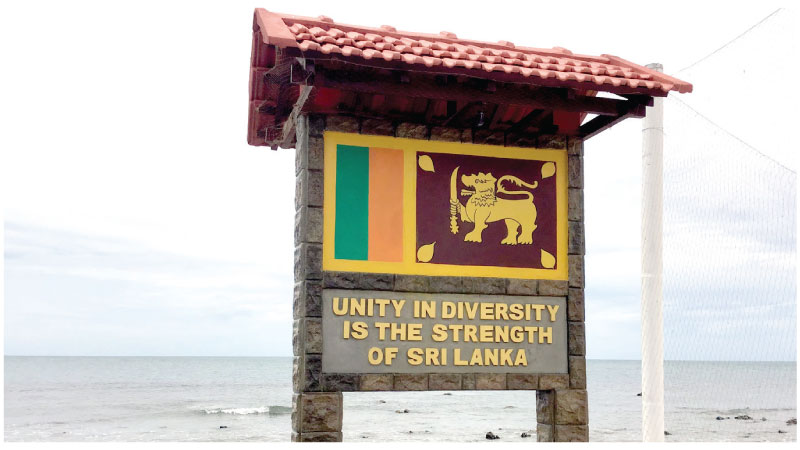Since the Sinhalese are mixed race to begin with (Bengali immigrants from the Vijaya lineage intermarrying with the Naga people who were native to Sri Lanka) are they more receptive to further mixing with other races and cultures, and are they proud of their Creole inhabitants among others?
 The Sinhalese have had no burning desire to call themselves pure, and that’s seen from the ready assimilation with other cultures and the taking of names from the Portuguese and so on.
The Sinhalese have had no burning desire to call themselves pure, and that’s seen from the ready assimilation with other cultures and the taking of names from the Portuguese and so on.
It will be argued that this was a minority that took such names, and that the vast mass of Sinhalese were against this type of assimilation. That’s a bit of a strained argument from a people that are of mixed-race in the first place i.e Bengali and Naga origins.
Besides that, the Sinhala language though of Indo-Aryan descent has been influenced and enriched by Tamil, and by languages as far flung as Tagalog in the Philippines, and so it is clear that the people of this country were not merely open to the winds of the world — they were in fact the winds of the world.
The several creoles that exist are another matter, and that is distinct proof that there are several strains of Sri Lankan.
But how much ownership do the Sri Lankans take of this mixed-race character of Sri Lankan-ness, and the highly intermingled nature of the Sinhala race per se? Perhaps the people as a whole are far more proud and celebratory of their mixed-race character than the historians and the experts so called would have us believe.
SCHOLASTIC
The Pereras, de Silvas and Fernandos are as much or more Sinhalese than the Sinhalese themselves, to the extent that of course there is no distinction. They are Sinhalese as much as the Sinhala Veddahs who speak the Sinhala Veddah creole in Bintenna are.
But yet no study has been done about the self-identification of Sinhalese as mixed race, and open to mixed-race influences. At least there is no major study that’s known that explores those areas of identity.
But people are not celebratory of this mixed-race identity, say, in the way that the Creole communities of Louisiana are proud of their Creole origins. They have Creole marches and Creole food festivals in New Orleans.
Of course it would be ridiculous to expect the Sinhalese to do that because the community is not Creole by a long shot. It’s the majority race within this island, and they don’t have a reason to consider their language or their culture Creole.
But yet language is one aspect, and pockets of communities living in various parts of the island are entirely another. Those such as H Cordoso and K.M de Silva wrote about the historical and linguistic aspects of Sri Lankan Portuguese Creole which is now of course an endangered language. The chief lexifier — a scholastic term used by linguists — was Portuguese, in this language.
But this was the lingua franca at least in administrative terms in the country for over 350 years, this Portuguese Creole.
It showed that the Sri Lankan people though they fought colonialism were also open, let’s say in patches, to colonial influence.
Likewise, if the island’s past is delved into there were considerable swathes of the populace which was open to all types of cultural and linguistic influences, to such an extent that it would be absurd to expect Sri Lankans not to be celebratory of such intermingling.
CELEBRATORY
We are proud of our Portuguese names, and there has been no mass movement towards ditching them. We are proud to the point of being jealous guardians, of the heavy use of red chilli in our cuisine for instance, which as a practice may have come from India or from the Portuguese even, though nobody is sure particularly, or wants to make sure.
Sajeeva Samaranayake, an independent scholar once argued that Sinhala is a patois that has not grown due to various reasons, but this would be highly contested.
It didn’t grow, in terms of numbers or users essentially, but does that make the language a patois?
Well in a relative sense yes, if the Subcontinent is taken as a whole, but in any event the world patois has been given negative connotations.
What’s important to remember is that Sri Lankans held onto their language and held onto their culture, the latter which is much more of a mix than the former. But my guess is that Sri Lankans are proud and essentially celebratory of the fact that there are mixed-race influences both within the mainstream of Sri Lankan life and in the pockets and the patches that are integral to Sri Lankan-ness.
This celebratory aspect in turn ought to be celebrated. The people are naturally inclined towards making the most of the fact that they are an intermixture.
This is so whether you’d consider the Sri Lankans in the maritime areas of the western and north western provinces who were influenced by the Portuguese, or those of the south eastern coasts who were influenced by the Sampan boatmen who docked here during their voyages to and fro from Indonesia.
The Sinhalese were prouder probably of their native Naga origins than the Bengali immigrant influence of 2500 years ago, which is somehow taken to be the point of departure for the beginning of Sinhala civilisation by the scholars.
Ordinary Sinhala people think differently and are aware and celebratory of their original Vedda identity. They don’t also pay homage to any geographical point of origin located out of the country, and are positive about the fact that Buddhism is an influence that was bought to bear from outside the island’s borders.
In other words the island is unique in its intermingled and multi-racial nature. Of course what more evidence is necessary of the country’s accepting nature of multi-culturalism than the ready acceptance of Buddhism — and of course the subsequent acceptance of Christianity and so on which of course may have come essentially via the route of colonialism?
OFFSHOOTS
The most illogical opinion adduced about the essential nature of the living in this country is the one that being an island, it has been insular.
The exact opposite is true. Being an island made the inhabitants very early participants in global trade networks, and merchants from the Middle East, India and South Asia, and as far away as China began trading here and creating outposts that were to inevitably influence the already multi-cultural character of this country. That’s anything but insular.
The country’s very multiculturalism led to a separate identity and if Sajeeva Samaranayake says Sinhala is a patois, it has to be said that Sinhalaness and Sri Lankan-ness developed free from any preponderant influence from outside of its shores, modern day colonialism perhaps being the exception. But colonialism has been the recent aberration.
We are multicultural, multilingual and so open to the winds of the world that pluralism has been a core element of the Sri Lankan identity and credo.
Some writers and thinkers pushback against this coloured character of the Sri Lankan and Sinhala identity, by trying to claim that there is some form of visceral purity that makes up the Sinhala and Sri Lankan character. A lot of them would not hear of speaking about the Sinhala and Sri Lankan identity interchangeably in the first place.
The historical record has beaten them to it and made their arguments irrelevant by and large. They rant against a self-evident truth — our rampant multiculturalism and mixed race identity — and such an exercise is always farcical.
This country is not an offshoot of any tradition, but many offshoots have probably grown off of its traditions. The people are slyly aware of this fact. They don’t celebrate anything because it’s supposed to be pure, but they celebrate much precisely because it isn’t.









